Pedro Almodóvar is one of my favorite filmmakers, his filmography is one of the longest compared to many directors. He’s always been ground-breaking by challenging stereotypes regarding gender and sexuality. His creativity and curiosity is embodied through quirky and unique looks, interior design, hairstyling and coloring in each frame and character. His favorite color is red and its present in every single one of his films. He has written and directed more than twenty films, amongst them: “Pepi, Luci, Bom y otras chicas del montón”, “Laberinto de pasiones”, “Matador”, “La ley del deseo”, “Mujeres al borde de un ataque de nervios”, “¡Átame!”, “Tacones lejanos”, “Todo sobre mi madre”, “La mala educación”, “Volver”, “La piel que habito”, “Julieta”, “The Human Voice”, “Madres Paralelas”, “Strange Way of Life”, “The Room Next Door”.
“Cuando invento un personaje, lo veo como una madre ve a su hijo. Y elijo la ropa, colores, al igual que un pintor, para evocar una emoción. (…) En mis películas, los colores, ya sea paredes o ropa, todos tienen para mí un significado dramático preciso. Si tuviéramos tiempo, diría a detalle el significado de cada color en cada pared en Julieta” (“Des douleurs, des couleurs”, Pedro Almodóvar, 2016)
[“When I invent a character, I see it like a mother sees a son. I choose the clothes, colors, just like a painter, to evoke an emotion. (…) In my movies, colors, either on walls or clothing, they all have a precise dramatic meaning to me. If we had time, I would explain in detail the meaning of each color in each wall in Julieta”]
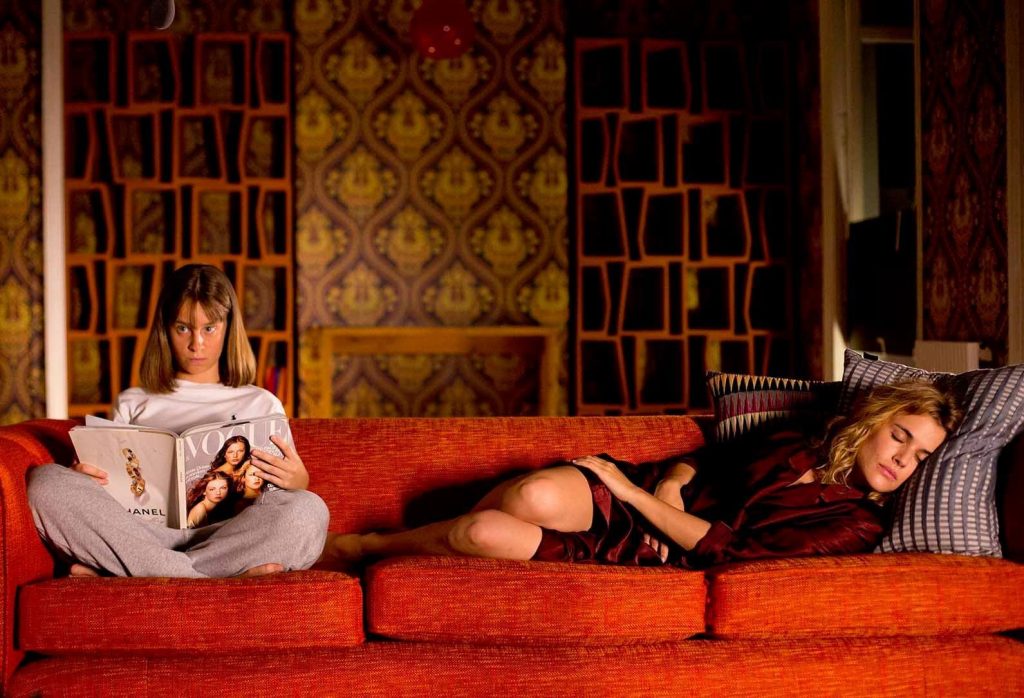
Almodóvar tends to brighten the room with primary colors and characters in stoic fashion. That fashion portrays functionality, comfort and seriousness within a tumultuous environment. Stoic fashion doesn’t get influenced by trends, just like Almodóvar’s characters don’t get influenced by anyone, they are firm in what they believe, and they stand their ground. For example, in “The Human Voice”, the woman is having a heart-felt passionate conversation with her husband through the phone. She is determined to communicate her feelings and even express feelings like resentment. In “Mujeres al borde de un ataque de nervios”, Pepa also wears a stoic suit showcasing her attempts to stay focused in the middle of the chaos. Which, fun fact, was inspired by Kim Basinger in “Blind Date”. Almodóvar is also masterful at expressing his characters’ personality through fashion, and even worked with designers like Giorgo Armani, Karl Lagerfeld, Jean Paul Gaultier, Missoni, Bulgari, Céline, David Delfín, and Dior.
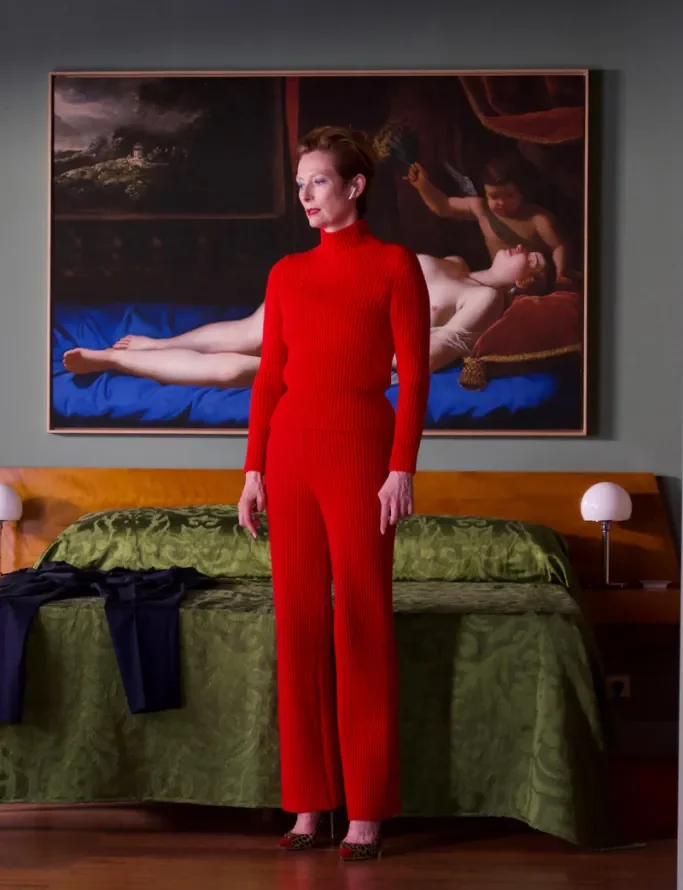
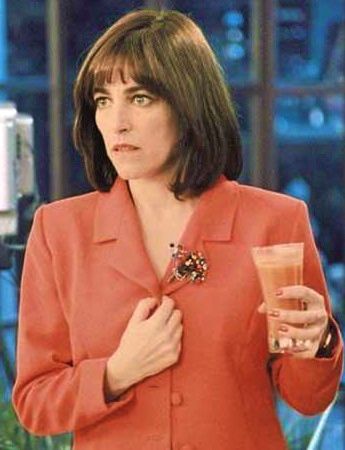
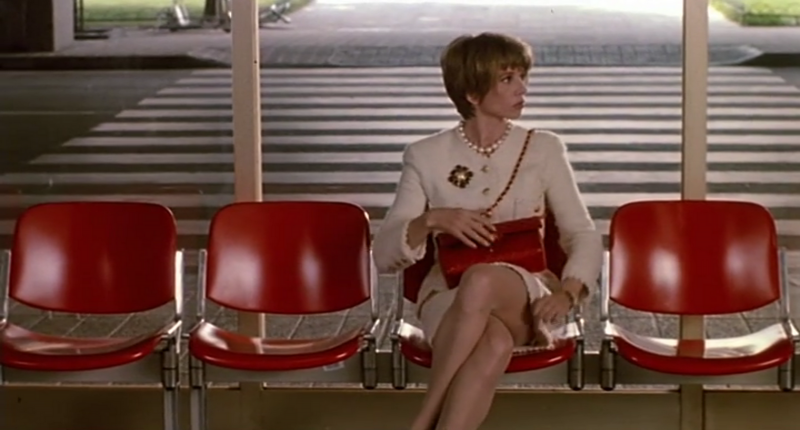
Becky del Páramo wearing Giorgio Armani in “Tacones Lejanos”
Red
Red is the color of the extreme, passion, fire. It is an outstanding color and rapidly perceived in nature. In our society, the symbolism around red differs from positive to negative perceptions. For example, red is mainly associated to fire or blood, therefore it is also perceived as a warm color, linked to the Sun or heat. Cultural and social positive associations for red include passion, energy, affection, love, sexuality, prosperity, strength, power, dynamism, and even, extroversion. On the other hand, negative associations include violence, rage, hate, aggression, lack of control, emotional impulses, excess, and danger.
“El rojo funciona muy bien en solitario, y combinado con casi todos los colores. Hay que pensar en las dosis porque puede saturar, o devorar al color que le pones al lado. Esto depende de la sensibilidad del autor. Mi combinación ideal es con el azul y el blanco, el resultado es refrescante, marinero, alegre y le favorece hasta al jorobado de Notre Dame. Me gusta mucho combinarlo con verde pistacho, solo si eres brasileño o caribeño puedes atreverte a combinarlo con otro tipo de verdes, pero ellos pueden. Adoro el rojo combinado con rosa chicle. (…) No es un color para tímidos sino para hombres y mujeres de carácter. El rojo es vida y muerte, no se puede pedir más” (Almodóvar in Architectural Digest, 2020)
[“Red works very well in solitary, and combined with almost every color. We must think of the dosage because it may saturate or devour the color you put next to it. This depends on the sensitivity of the author. My ideal combination is with blue and white, the result is refreshing, navy, joyous, and it even sits well on the Hunchback of Notre Dame. I really like combining it with pistachio green, only if your Brazilian or Caribbean you can dare combine it with other types of green, but they can. I adore red combined with bubblegum pink. (…) It is not a color for the shy, but rather for men and women of character. Red is life or death, you can’t ask for more”] (Almodóvar in Architectural Digest, 2020)
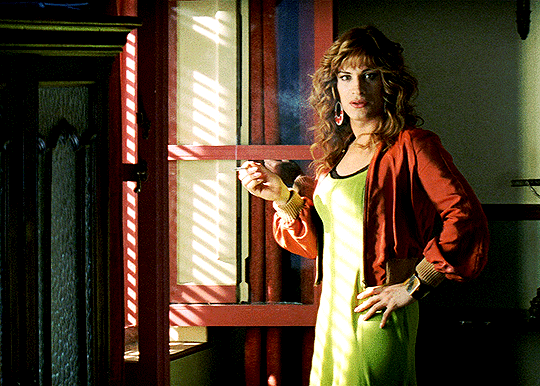
Pistachio Green and Red in “La Mala Educación”
As he said so, red is a color for men and women of character. If we analyze Almodóvar’s filmography, we will notice how most of his characters are strong and determined women. The red on or around them signifies their bold and decided spirit. His female characters are courageous, calculated, focused, but some of them are also visceral or impulsive.
In “Todo sobre mi madre”, Manuela is driven but also impatient and restless after her son’s passing. She’s wearing red when she leaves the theater after watching “A Streetcar Named Desire” with the famous actress, Huma Rojo, whose last name is red, and is redheaded. The color, as well as the story express intensity and tragedy. Huma becomes an emotional pillar for Manuela, just as Manuela becomes one for the rest of the women. In this movie, red is also support.
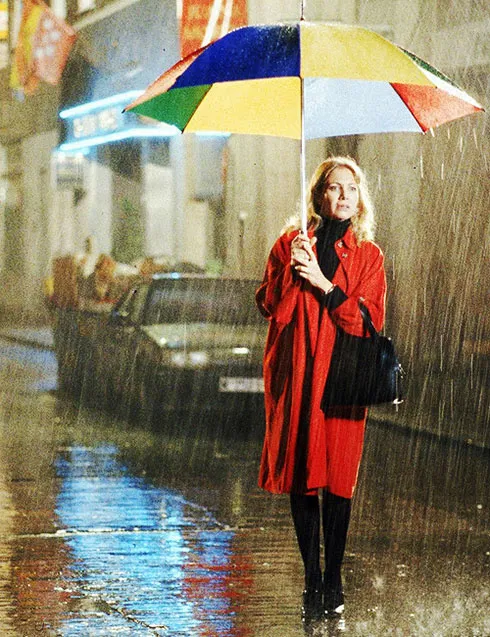
In “Volver” both sisters have lost their mother in a fire. The family is led by them, showing the strength and determination within this matriarchal dynamic. Raimunda is a working-class single mother, willing to do anything to protect her daughter, Paula. To make matters worse, her mother, Irene, comes back from the dead to help tie loose ends. In this movie, red is resilience, death, and fire.
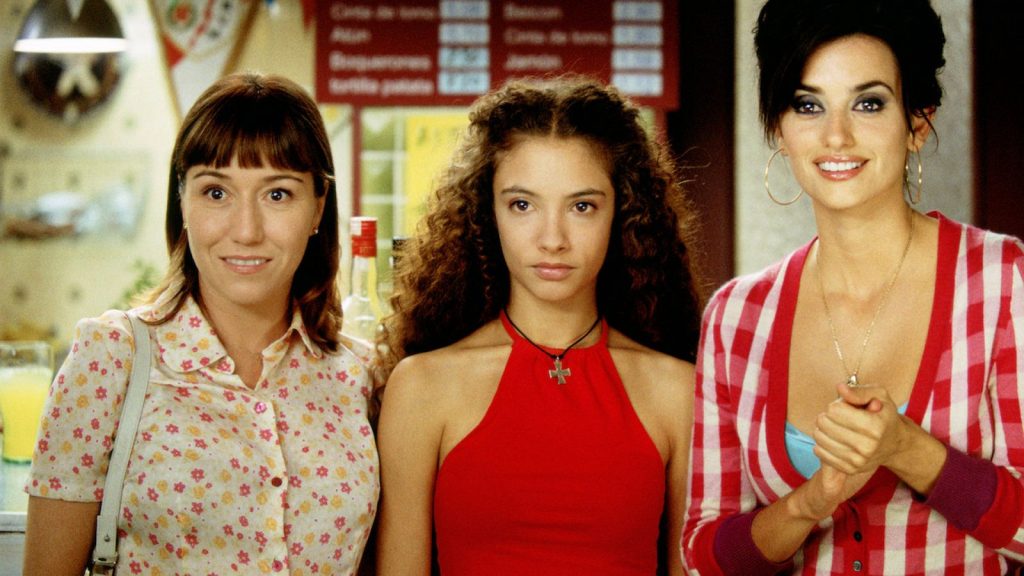
In “Mujeres al borde de un ataque de nervios” Candela is docile, noble, and foolish. She couldn’t harm anyone. Hence, her clothing is mainly yellow or beige. Lucía is between madness and reason, she has just left the psychiatric hospital and feels lost, but also desperate for revenge against Iván, who repeatedly cheated on her throughout their marriage and then abandoned her. Her clothing is pink, perhaps as a good combination for red, since Almodóvar mentioned he loves bubblegum pink with red, but also because she is under the red grading scheme, yet not entirely on red. Meaning, she is stuck in the middle, just as pink would be. Not too bright, not too light. We don’t get to see Marisa much since she is mostly asleep, however we feel her energy the moment she steps foot in Pepa’s apartment. She imposes, she takes space, she is present, she controls Carlos and looks down on Pepa and Candela.
Pepa is initially devastated and angry after Iván went missing. She is laser focused on finding him, especially because she’s pregnant. She knows what she wants, and she is sharp with her words. She doesn’t lose time and the Gazpacho she prepares takes an important space on screen because initially it’s a way for her to find some calmness and a way of getting out of her head enjoying her meal. She doesn’t eat the Gazpacho right away and rather puts it in the fridge. Hours later, when the police stops by her apartment looking for Candela and Carlos, she laces the Gazpacho with sedatives, giving herself and the rest of the characters some time to think. In this movie, red is ambivalence, impulsion, strategy, and lack of control.
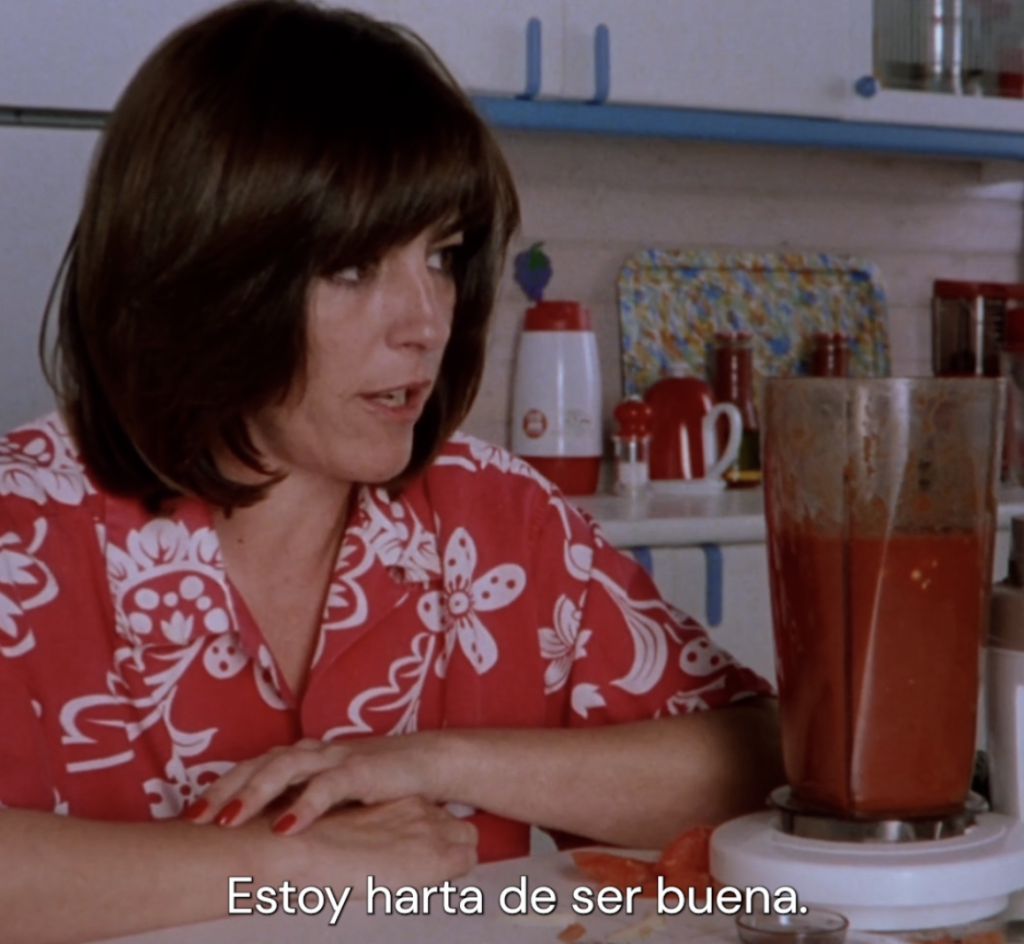
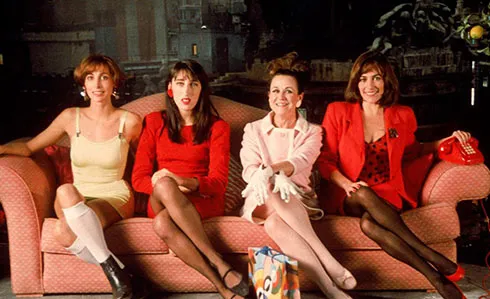
Kitsch and Maximalism
If color theory and fashion isn’t enough, Pedro Almodóvar is also an expert when it comes to Avant Garde in interior design. Interior spaces in Almodóvar’s films are often Kitsch designed or Maximalist.
Kitsch refers to art or design perceived as poor taste due to excessive decoration or sentiment. It originated in the 19th century to judge art considered as “high art”, opposing bourgeoisie views that displaced art from emotional expression. Kitsch became associated with commodities and cheap entertainment. Around the 1960s it began to mix with Pop Art, embracing elements of mass media, hyper consumption, and advertisement.
Some interiors in Almódovar’s films are the perfect showcase between Kitsch and Pop Art. We can appreciate this by noticing striking colors, bright spaces, pastel colors, pure and symmetrical lines. We can also observe famous individuals or a popular characters hanging from a wall. For example, in “The Room Next Door” we can admire a bright blue couch with red lines, red, yellow, blue and black books and objects on the table and side tables, and a painting of one of the main characters, Martha portrayed by Tilda Swinton, hanging on the wall.
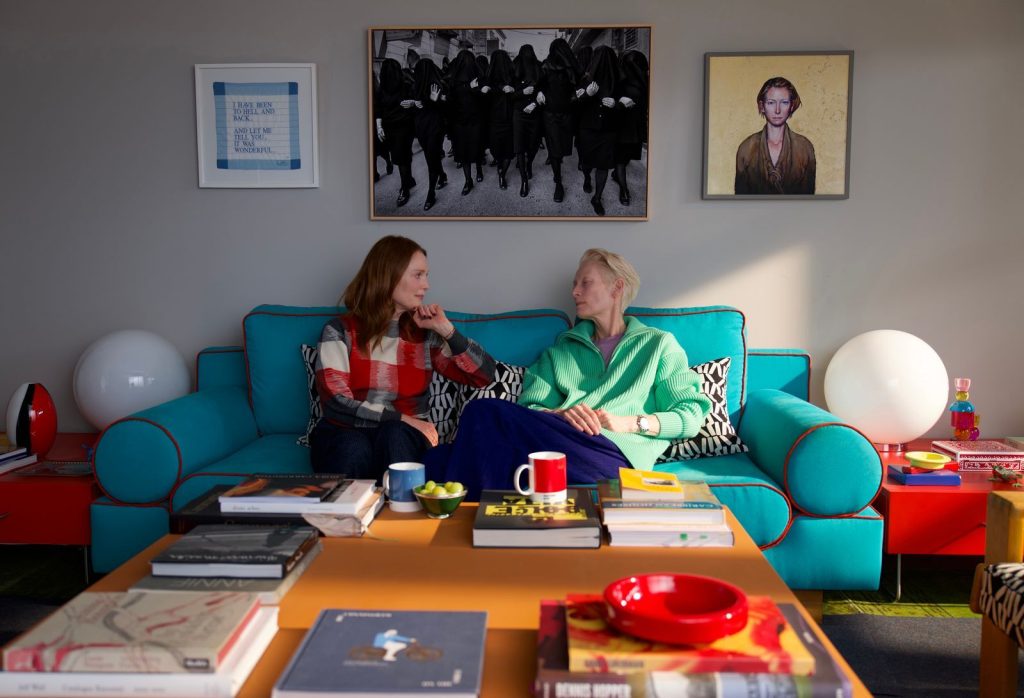
Maximalism is another prevalent artistic movement in Almodóvar’s interiors. It contrasts minimalism, preaching “more is more”. It represents a rejection of strict values and rigid rules post World War II. It embraces diversity and blurs the lines between reality and fiction, encouraging curiosity, creativity, multiculturalism, and spontaneity. This is also directly related to Almodóvar’s films frequently exploring themes of gender and sexuality, featuring trans characters, often portrayed as joyful and empowered individuals. His work challenges traditional gender norms and offers a fluid view of gender identity. His movies explore flexibility of gender identity, defying conservative, and binary views on it.
Trans Characters in Pedro Almodóvar’s films:
· Law of Desire (1987):
Tina, Quintero’s sister, is a trans character played by a cis actress, Carmen Maura, who portrays an exaggerated and theatrical version of femininity, highlighting the performance of gender.
· All About My Mother (1999):
La Agrado, a transwoman, is portrayed as a vibrant and positive character who finds freedom and joy in her identity, and she’s played by a trans actress, Antonia San Juan.
· The Skin I Live In (2011):
Vera, the central character, is the result of a forced sex change, highlighting the complex relationship between gender identity, captivity, and the constructed nature of identity.

ArchDaily. (2023, July 21). Maximalism: What it is and why you need to know it. https://www.archdaily.com/1007027/maximalism-what-it-is-and-why-you-need-to-know-it
Almodóvar, P. (2023, June 12). Pedro Almodóvar escribe en exclusiva sobre su relación con el color rojo. AD España. https://www.revistaad.es/decoracion/articulos/pedro-almodovar-escribe-exclusiva-sobre-relacion-con-color-rojo/26696
Avant Arte. (n.d.). Kitsch. https://avantarte.com/glossary/kitsch
Oscar Castillero Mimenza. (2018, septiembre 4). ¿Qué significa el color rojo en Psicología?. Portal Psicología y Mente. https://psicologiaymente.com/psicologia/que-significa-color-rojo





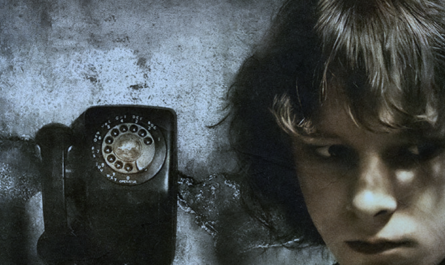
расчет стоимости охраны [url=https://rabochiy.site/]https://rabochiy.site/[/url] .
Lovart’s AI-driven design approach is a game-changer for creative workflows. I love how it blends traditional tools with smart suggestions. Definitely worth checking out for designers looking to level up their process with Lovart.
rk5c1h
v6avcj
**mindvault**
Mind Vault is a premium cognitive support formula created for adults 45+. It’s thoughtfully designed to help maintain clear thinking
**mind vault**
mind vault is a premium cognitive support formula created for adults 45+. It’s thoughtfully designed to help maintain clear thinking
**sugarmute**
sugarmute is a science-guided nutritional supplement created to help maintain balanced blood sugar while supporting steady energy and mental clarity.
**gl pro**
gl pro is a natural dietary supplement designed to promote balanced blood sugar levels and curb sugar cravings.
**prostadine**
prostadine is a next-generation prostate support formula designed to help maintain, restore, and enhance optimal male prostate performance.
**prodentim**
prodentim an advanced probiotic formulation designed to support exceptional oral hygiene while fortifying teeth and gums.
**glucore**
glucore is a nutritional supplement that is given to patients daily to assist in maintaining healthy blood sugar and metabolic rates.
**vittaburn**
vittaburn is a liquid dietary supplement formulated to support healthy weight reduction by increasing metabolic rate, reducing hunger, and promoting fat loss.
**synaptigen**
synaptigen is a next-generation brain support supplement that blends natural nootropics, adaptogens
**nitric boost**
nitric boost is a dietary formula crafted to enhance vitality and promote overall well-being.
**wildgut**
wildgutis a precision-crafted nutritional blend designed to nurture your dog’s digestive tract.
**mitolyn**
mitolyn a nature-inspired supplement crafted to elevate metabolic activity and support sustainable weight management.
**zencortex**
zencortex contains only the natural ingredients that are effective in supporting incredible hearing naturally.
**yu sleep**
yusleep is a gentle, nano-enhanced nightly blend designed to help you drift off quickly, stay asleep longer, and wake feeling clear.
**breathe**
breathe is a plant-powered tincture crafted to promote lung performance and enhance your breathing quality.
**pinealxt**
pinealxt is a revolutionary supplement that promotes proper pineal gland function and energy levels to support healthy body function.
**energeia**
energeia is the first and only recipe that targets the root cause of stubborn belly fat and Deadly visceral fat.
**prostabliss**
prostabliss is a carefully developed dietary formula aimed at nurturing prostate vitality and improving urinary comfort.
**boostaro**
boostaro is a specially crafted dietary supplement for men who want to elevate their overall health and vitality.
**potent stream**
potent stream is engineered to promote prostate well-being by counteracting the residue that can build up from hard-water minerals within the urinary tract.
**hepatoburn**
hepatoburn is a premium nutritional formula designed to enhance liver function, boost metabolism, and support natural fat breakdown.
**hepato burn**
hepato burn is a potent, plant-based formula created to promote optimal liver performance and naturally stimulate fat-burning mechanisms.
**flow force max**
flow force max delivers a forward-thinking, plant-focused way to support prostate health—while also helping maintain everyday energy, libido, and overall vitality.
**prodentim**
prodentim is a forward-thinking oral wellness blend crafted to nurture and maintain a balanced mouth microbiome.
**cellufend**
cellufend is a natural supplement developed to support balanced blood sugar levels through a blend of botanical extracts and essential nutrients.
**neurogenica**
neurogenica is a dietary supplement formulated to support nerve health and ease discomfort associated with neuropathy.
**revitag**
revitag is a daily skin-support formula created to promote a healthy complexion and visibly diminish the appearance of skin tags.
**sleep lean**
sleeplean is a US-trusted, naturally focused nighttime support formula that helps your body burn fat while you rest.
**memory lift**
memory lift is an innovative dietary formula designed to naturally nurture brain wellness and sharpen cognitive performance.
It’s fascinating how accessible music creation is becoming! Tools like Sprunki Mod really lower the barrier to entry – no downloads or complex software needed. Inspiring to see that urban aesthetic combined with pro sound design! ✨
Quoten aktualisieren sich in Sekundenschnelle und bieten neue Chancen mit jedem Spielzug.
Letzterer bietet kleine Sofortgewinne ohne komplizierte Bedingungen – perfekt für zwischendurch.
Slots zählen zu 100% zum Umsatz, während Tischspiele und Live Casino nur mit etwa 10% angerechnet werden.
Der virtuelle Sportbereich läuft rund um die Uhr und bietet Simulationen von Fußball, Tennis, Pferderennen, Basketball und Hunderennen. Die Plattform bietet ein umfangreiches Belohnungssystem für Casino und Sportwetten. Die Spielebibliothek der Plattform beeindruckt durch ihren Umfang – mehr als 6.000 Slots, Tischspiele und Live-Tische von über 120 Providern. Werfen wir also einen Blick darauf,
was diese Plattform bietet, für wen sie geeignet ist und wer sich besser nach einer Alternative umsehen sollte.
Unsere Website ist responsiv gestaltet und bietet eine intuitive Benutzeroberfläche sowie eine flüssige Navigation über verschiedene Bildschirmgrößen hinweg.
Im BetHall Casino sorgen wir dafür, dass unsere Plattform vollständig für mobile Geräte optimiert ist, damit du deine Lieblingsspiele reibungslos auf Smartphones
und Tablets genießen kannst. Wir bieten verschiedene Optionen für Auszahlungen an,
um dir einen schnellen Zugriff auf dein Guthaben zu ermöglichen.
References:
https://online-spielhallen.de/malina-casino-spiele-bonus-anmeldung/
Aber der berühmte Las Vegas Strip spielt bei The Gambler nur eine Nebenrolle.
Besonders aufregend ist der Showdown, bei dem Jim am Roulette-Tisch um seine Zukunft
und die Zukunft der Menschen, die ihm am nächsten sind, spielt.
Alvin Ing spielt Lee, den Betreiber eines illegalen Casinos.
Diese Aktivitäten erregen bald zu viel Aufmerksamkeit, und
Nicky wird schließlich auf die Schwarze Liste gesetzt, was ihm den Zutritt zu den Casinos verbietet.
Der Film zeigt die engen Verbindungen der Mafia zum Glücksspiel in Las Vegas
in den 1970er Jahren. Die Produktionskosten betrugen etwa 52 Millionen US-Dollar,
und der Film spielte weltweit 116 Millionen ein. Martin Scorsese schrieb das Drehbuch
gemeinsam mit Pileggi und setzte damit seine Zusammenarbeit nach Goodfellas fort.
Wie in einem Casino, in dem die Verführung des schnellen Gewinns lockt,
zeigt Scorsese in diesem Film, wie die Gier zum unausweichlichen Ruin führt.
Joe Pesci macht den Eindruck des unberechenbaren Nicky Santoro, und Sharon Stone spielt die verführerische Ginger McKenna.
Mit dem Film „Casino“ schafft Martin Scorsese ein packendes Mafia-Drama, das in den schillernden 1970er Jahren in Las Vegas spielt.
References:
https://online-spielhallen.de/zetcasino-deutschland-einloggen-spielen-auszahlen/
link 66b nổi tiếng với dịch vụ cá cược thể thao đa dạng, bao gồm các môn thể thao phổ biến như bóng đá, bóng rổ, tennis, đua ngựa và nhiều giải đấu lớn trên toàn cầu. Người chơi có thể tham gia đặt cược trực tiếp, với tỷ lệ cược luôn được cập nhật liên tục, đảm bảo sự minh bạch công bằng. Không chỉ vậy, nơi này còn cung cấp nhiều loại kèo khác nhau, từ kèo châu Âu, kèo châu Á, kèo tài xỉu cho đến kèo phạt góc, kèo hiệp phụ nhiều hình thức cược khác, đáp ứng đầy đủ nhu cầu của khách hàng. TONY12-11A